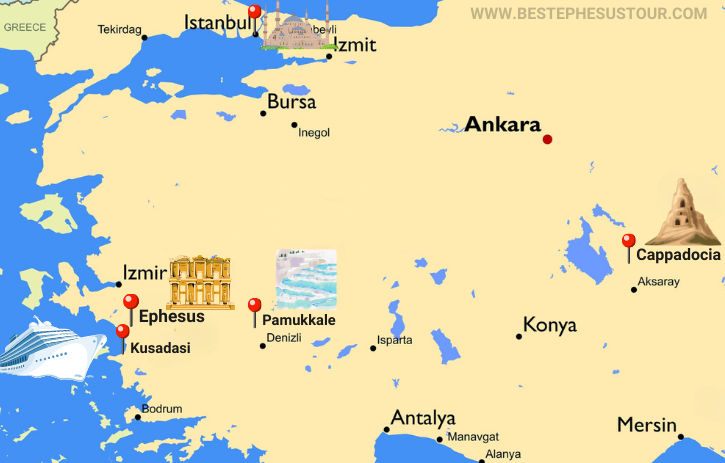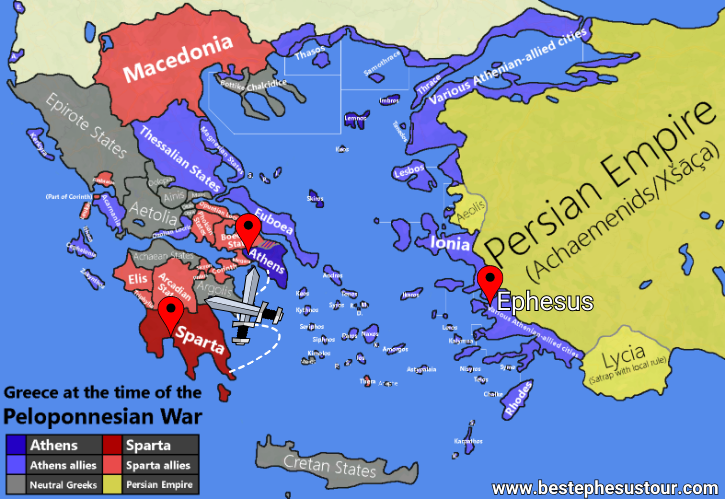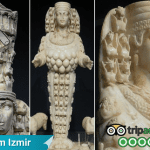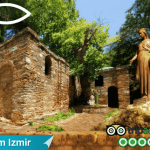Quick Overview
The ancient city of Ephesus is located in the Selcuk district of the city of Izmir in modern-day Turkey. It is one of the best-preserved and most important archaeological sites of the ancient world. With a population of around 250,000 in the Roman period, Ephesus was the third-largest city of the Roman Empire and the capital of the Asia province. What makes Ephesus important is not only its antiquity but its religious significance, especially for Christians. So that, St. John the Evangelist lived and died in Ephesus, St. Paul delivered his speech to the Christian community in the Ephesus theater, and the Virgin Mary, the mother of Jesus, lived on Bulbul Mountain near Ephesus.
Table of contents
Where is Ephesus Today?

The ancient city of Ephesus is located in modern-day Turkey. It lies on the western coast, in the present-day town of Selcuk in İzmir Province. The ancient city of Ephesus is approximately 550 km from Istanbul, 75 km from Izmir, 185 km from Pamukkale, 800 km from Cappadocia, and 15 km from Kusadasi, which is a popular destination for cruise tourism. There are direct flights from Istanbul and Cappadocia to Izmir Airport, which take approximately 1 hour. Izmir Airport is 70 km from Ephesus, and there are various transportation options available.
History of Ephesus
The Origins of Ephesus
The Hittite sources of the 14th century B.C. mention the Ahavia Kingdom and the important city Apasas of this kingdom. It is known that the Ahavia kingdom had been established around the Miletos region. The closeness of Miletos to Ephesus and the resemblance of Apasas with Efes, Ephesus, or Ephesos suggests that the former name of Ephesus was Apasas. The most ancient findings in Ephesus are from the Mycenaean era, tomb gifts (cups) dating back to the 13-14 centuries B.C. Having not found any Mycenaean living centers during the excavations during the last century might indicate that Apasas had commercial relations with Mycenae.
Legendary Foundations
The Amazons and Early Inhabitants
According to the antiquity authors Strabon (1. cent. B.C.) and Pausanias (2nd cent. A.D.) Ephesus was founded by the Amazons. Strabon also says that Ephesus was the name of an Amazonian Queen. The fact that there was no unity among the people living in West Anatolia, was a reason for Hellenic people who were speaking Aiolis, Ionic, and Doric dialects, to immigrate to those regions and build colonies there. And again because these people created a religious ritualistic unity, names such as lonia and Aiolis were given to the coasts. In the Ionian region, where Ephesus was situated, too, were 12 cities. These were Miletos, Myus, Priene, colophon, Lebedos, Teos, Clozomenai, Phokaia, Erythrai, Samos, and Chios. The representatives of these Ionian cities would gather in a place called Panionion. The Panionion which was on the Mykale peninsula and to the south of Kusadast, and which is now within the limits of the Güzelcamli village, was a place where every year half-religious rituals were held.
Colonization and Mythological Foundation
The Oracle’s Prophecy and Androklos
The colonization in Ephesus was completed in the 10th century B.C. Strabon and Pausanias tell us the story of the foundation of Ephesus as follows “The Athenian King Kodros’ son Androklos and his friends who wanted to immigrate to the West Anatolian Coasts asked the Apollonian Oracle where to build the new city. The Oracle tells them that a fish and a wild boar would show them the place. After a long journey, they arrived at the Krystos Coast. There while frying the fish they had caught, one of the fish jumped out of the pan and set a fire by burning the dry grass around. A wild boar that had been lingering in the bushes around ran away with fright. Androclos who had seen it chased it with his horse and shot it on a small hill by Koressos. Believing that the prophecy of the Oracle had come true they decided to build the city there.
Relations with Natives and the Cult of Artemis
Androklos who is considered as the ktistes (mythological founder) of Ephesus, makes good relations with the natives Carians and Lelegians. These relations are strengthened by the resemblance of the characteristics of the Mother Goddess Kybele of the Anatolians with those of the Goddess Artemis of the newcomers. When Androclos is killed in a war he is buried in Smyrna and a heroon is built on his tomb. According to Strabon, Smyrna (Modern name Izmir) was the name of the open area in front of the Magnesia Gate. The residents later deserted Ephesus and founded the city Smyrna (Izmir). The 9th and 8th centuries B.C. of Ephesus are dark, just like all other western Anatolian cities. It is supposed that Ephesus was a small city ruled by the children of Androklos.
Invasions and Rebuilding
The Kimmerian Invasion
In the 7th century B.C. Ephesus was attacked by the Kimmer tribe like the other, Ionian cities were. The Kimmer who invaded the region in a fury did not stay long. They left after destroying the Artemis Temple. After the Kimmer invasions Ephesus again collected itself and gained a lot of fame in science, technology, and wealth because of the Artemis Temple, among the neighboring cities.
Lydian Conquest and Croisos’ Influence
In the 6th century B.C., the Lydians became a very powerful state, especially through its capital Sardes, and they attacked Ephesus. The citizens of Ephesus did not take the attack of the Lydian king Kroisos too seriously because they believed that their Goddess Artemis would protect them. But things did not turn out as they expected, and the Lydians entered Ephesus. Kroisos treated them well and he contributed to the Artemis Temple which was being built. According to Strabon, he gave Columnea Caelata (engraved columns) which had his name on them. The column on which his name was engraved and other precious gifts made of ivory and gold were found during the first excavations and taken to the British Museum. Croisos also forced the people to live in the newly founded block sites around the Temple. So the citizens deserted Cresos, which they had inhabited for 400 years, and started to live by the famous Temple. The silts carried by the river Cystros covered the city with a slam. Croisos, after Ephesus, included other Ionian cities under his reign.
Persian Invasion and Control
Cyros, who took the lead in Persia and tried to take advantage of the fights in Persia, started for Cappadocia. But there he helped the Cappadokians instead of fighting them. The winner of the fight is not clear. Croisos gave his hired men leave until spring, the time when he planned for a new attack. But Cyros and his strong army suddenly appeared in front of Sardes. The Lydians had to surrender. Croisos fell prisoner. According to Herodot, Cyros sent messengers to Ionian cities before he attacked Lydia, to ask them to rebel against Croisos and take his side during the war. But except for Miletos, no other city accepted this. After the fall of Sardes, the Ionian and Aiolos cities sent representatives declaring that they were willing to be committed under the same conditions set by Croisos. But they could not prevent a Persian attack. The famous Persian commander Harpagos invaded all of West Anatolia starting from Phokaia (Foca) in 546 B.C.
Persian Administration and Satrap System
The Persians, by unifying Ionia, Aiolis, Caria, Likia, Pamphilla, and South Lydia, founded the Ionian Satrap which they called Yauna, and made Sardes it’s capital. During the Persian reign, Ephesus was free with its inner affairs, and it continued its commercial relations. The Ionian Satrap paid Persia 400 Talents in silver as tax. The Persians took soldiers from Ephesus whenever necessary and used the Harbor of Ephesus as a base. The tax taken by the Persians was not lifted after Cyros; on the contrary, it was increased during the reigns of Kymbses and Dareios. This was a situation that made people long even for tyranny again.
The Ionian Revolt
Aristagoras’ Rebellion and the Attack on Naxos
In the year 500 B.C. Aristagoras, who was the tyrant of Miletus, the richest and biggest city of Ionia, convinced the Satrap of Sardes, Artaphernes, to attack the Naxos island. This attack, which lasted for four months, brought the Persian army no success, and they had to retreat. Aristagoras, who felt that his position was becoming somewhat shaky, provoked Miletus against the Persians. Plus, he presented himself as the savior of the people who were complaining of high taxes, and so he made other Ionian cities rebel against Persia. The rebels gathered at Ephesus and, following the Cystros Coast for three days, they arrived at Sardes. They took the city without a battle.
The Burning of Sardes
Only the Satrap Artaphernes could defend himself by withdrawing into the inner fortress. One of the rebels set a house on fire, and because the tops of the houses were made of bamboo, the fire spread very quickly and burned down the whole city. The Kybele Temple also burned down in this fire. This was then used by the Persians as an excuse when they burned down the temples of the Greeks.
The Defeat at Ephesus
When the rebels found out that a strong Persian army was coming towards them, they started to flee back. The Persian army reached Ephesus by following the Ionians, and there they defeated the Ionian forces. In this war, which is called the “Ephesus Battle,” most of the Ionian soldiers were killed. Nevertheless, the revolt grew and spread all over the Aegean Islands.
The End of the Ionian Revolt
The Ionian revolt came to an end in 494 B.C. when the Ionian navy was defeated by the Persians near Lade Island. The Persians first burned down Miletus. They took some of its inhabitants as slaves to Persia and other places. Then they again attacked Ionian cities and plundered them. The Ionian revolt did as much harm to the people of Chios as it did to the citizens of Miletus. The Chians, whose ships were sunken and who were chased by the Persians, came to the Mycale coast and put their ships ashore. They walked night and day until they came near Ephesus. The citizens of Ephesus were at that time celebrating the Thesmophoria holiday, in which only married women could participate. When they saw the armed Chians, they thought that these were bandits who came to take away the women, and so they killed all of the Chians.
Persian Defeat and the Rise of Athens
In 479 B.C., the Persian commander Mardonius, after invading central Greece and Attica again, was defeated and killed in Plataea. Just after this, Spartans set up a surprise attack on the Persian navy and burned down the whole fleet. After this victory against the Persians, the Ionian cities again revolted to kick the Persians out of Anatolia just as they had been kicked out of Greece. They joined the ‘Athens-Delos Sea Union,’ which was established by the leadership of Sparta and Athens. According to Thucydides and Aristo, Ephesus paid 7.5 talents in 453 B.C., 6 talents in 444 B.C., and 7.5 talents in 436 B.C. as a participation fee. If it should be considered that the amount of the fee was taken for its financial power, then it can be concluded that Ephesus was one of the wealthier cities.
The Peloponnesian Wars

During the Peloponnesian Wars, Ephesus took first Athens’ side and then Sparta’s. In the year 409 B.C., the Athenian commander Thrasyllus, whose fleet consisted of 50 ships, attacked and plundered Pygela, which is to the south of Ephesus. Later he attacked Colophon and Metropolis, which are to the south of Ephesus, and plundered the villages there. The Persian regional commander Stages attacked the Athenians but could not keep them from retreating to another place called Notion. The Ionian Satrap Tissaphernes asked all the Ionian cities to defend the Artemis Temple against a possible attack by Thrasyllus. The Athenians lost the fights that took place around the city of Ephesus.
Alexander the Great in Ephesus
To kick out the Persians from Anatolia just as he had kicked them out of Greece, Alexander with his strong army of 30,000 infantry and 5,000 horsemen crossed the Dardanelles and reached Anatolia. From there, he went to the city of Elaeus, which is near Troy, and there made a sacrifice by the tomb of Protesilaus, who was the first man to set his foot ashore and be killed. Then he made sacrifices by the tomb of Achilles and in the Athena Temple. When the Ionian Satrap, Spithridates, found out that Alexander was in Anatolia, he set out with a strong army to stop him. According to Alexander’s historian Arrian, the army consisted of 40,000 infantry and 20,000 horsemen. The war, which Arrian called ‘The War of the Horsemen,’ took place by the banks of the Granicus River and did change the fate of antiquity. During the war, just as Spithridates was about to hit Alexander with his sword, he was killed by a Macedonian. Commander Mithridates, the son-in-law of Darius, was killed by a spear thrown by Alexander. Alexander, who won this battle, transferred the whole rights of the Satrap to Assandros, the son of Philotas. After a four-day walk from Sardes, Alexander came to Ephesus.
Alexander’s Entry into Ephesus
The Greeks hired soldiers who heard that the Persians were defeated and that the Satrap was killed, got hold of two Persian galleys in the Ephesus harbor, and fled. Alexander entered Ephesus without any resistance and said that he put an end to the governing of the Persian minority, and he announced that he established a new folk government. When the citizens of Ephesus started to attack the houses of the former governors and even started to kill them, Alexander stopped them from doing so. He then made a law that said that the amount of tax paid to Persia should be given to the Artemis Temple instead. He offered sacrifices to Artemis, and on his last day of stay, he made a parade with his army. On the night Alexander was born, a madman named Herostratus, who wanted his name mentioned throughout history, burned down the archaic Artemis Temple. Alexander visited the new Temple which was being built instead of the old one, and he said that he wanted to pay all the expenses for the Temple. But the citizens of Ephesus refused him politely by saying that it wouldn’t be suitable for one god to give presents to another god.
The Reign of Lysimachus
After Alexander’s death, Ephesus was still, for some time, under the reign of Assandros who was in Sardes. Even though in the year 313 B.C., Monophthalmos or Cyclops Antigonus took over the reign under the name of the Macedonian Kingdom, there was a big competition for the position all over Anatolia. The Empire fell into pieces. Antigonus (80) was defeated and killed by Lysimachus in the Ipsus war, and so Lysimachus took over the reign of most of Anatolia (301 B.C.). According to Strabo, Lysimachus rebuilt Ephesus between the Pion and Koressus Mountains and the city walls which have remained in good shape until today, and he named the city Arsinoe after his wife (287 B.C.). However, the name could not gain any popularity among the citizens.
The Seleucid and Ptolemaic Rule
West Anatolia came under the reign of Seleucus after the death of Lysimachus (281 B.C.) in the Corupedian War. Ephesus accepted the reign of the Ptolemies during the time of Antiochus Theos and then again accepted the Seleucids in 196 B.C. In 188 B.C., Pergamum became the ruling kingdom after the Apamea peace. Attalus III became the king of Pergamon after the death of his uncle Attalus II. Even though Anatolia was in a state of disorder during his reign, Attalus did not fight any battles with anyone except for the Bithynians. It can be said that he did not interfere with the affairs of the State but left this to other people he trusted. Because he was afraid of being killed, he studied biology, zoology, pharmacology, and especially poisonous plants. In his testament, he gave the kingdom over to Rome (133 B.C.). But his brother Aristonikos (who is of the same father but whose mother is a woman from Ephesus) did not accept this. First, he persuaded the slaves by promising them freedom, and then he convinced the Royal Army in Phokaia. With the help of the Phokaian fleet, he got hold of the coastal cities such as Colophon and Samos.
Roman Rule and the Mithridatic Wars
Roman Rule in Ephesus
While Aristonikos’ fleet was awaiting him at the Kyme harbor, it was attacked by the strong Ephesus fleet which was on the Roman’s side, and it was destroyed. Even so, the revolt spread to the Ancient Settling Areas of Western Anatolia. The army sent from Rome under the command of Lycinius Crassus Mucianus was defeated as well. Mucianus made one of the soldiers kill him. Another army sent in 130 B.C. under the command of Marcius Perperna was able to beat Aristonikos, and so he added the lands of Anatolia to those of Rome.
The Great Revolt and the Ephesus Massacre
After a short time in 129 B.C., because of the heavy taxes and the poor governing that arose as a result of the Asia Province System, discontent began to show itself in Asian countries. Because of this, Ephesus, along with many other Anatolian cities, took the side of the Pontus King Mithridates VI, who had rebelled against Rome. When Mithridates came to the Aegean Sea from the Black Sea with his strong fleet of 300 ships, every city welcomed him as the savior.
80,000 Ephesians were Massacred in one day
He ordered that every Roman or Roman-originated person in Ephesus had to be killed (88 B.C.). Eighty thousand people were killed in one day. After this, Pergamon became the new capital of the Pontus Kingdom. The Roman commander Aquillius, who was taken prisoner and famous for accepting bribes, was sentenced to death by swallowing melted gold. In the same year, the Pontians took over Greece too, but in 87 B.C., the Roman army under the command of Sulla took Athens back and marched towards West Anatolia. Mithridates had to leave Pergamon because of the strong Roman Army, and he was forced to move to Pitane, another harbor. Meanwhile, commander Lucullus, under the order of Sulla, with his fleet achieved many victories in Rhodes. Sulla, whose intention was to return to Rome and suppress those who were against him, accepted the conditions of Mithridates and made an agreement with him. He took 3000 talents from him as war expenses. In addition, he collected 20,000 talents from other Anatolian cities to cover the expenses of the war he planned to fight in Rome. But the war did not come to an end. Mithridates did not give in, although he was defeated many times. He continued the war after taking shelter with his son-in-law, a king in eastern Anatolia.
Conclusion of the Mithridatic Wars
Commander Lucullus fought Mithridates VI for many years, who finally got one of the soldiers to kill him (63 B.C.). After this, the Roman armies that came to Asia punished those who revolted against Commander Sulla and they bound the whole of West Anatolia to Rome.
The Roman Empire and the Byzantine Period
Marcus Antonius in Ephesus
Antonius came to Ephesus after the Philippi War. The citizens of Ephesus, who knew his fondness for the Dionysus festivals, welcomed him in a festive way on the streets.
Conflict with Octavianus (Augustus)
Marcus Antonius sent his armies to Cilicia when his relations with Octavianus (Augustus) were somewhat tense. He returned to Ephesus in 33 B.C. with Cleopatra. He then fought Octavianus in Actium together with Cleopatra’s fleet of 200 ships but was defeated and so he returned to Egypt and besieged Alexandria. First, Antonius committed suicide out of despair, and after him, Cleopatra did the same. After this victory, Octavianus became the first Emperor with the decision of the Senate and took the title Augustus (27 B.C.).
Augustus’ Influence on Ephesus
Augustus changed the capital from Pergamon back to Ephesus and turned it into the biggest, leading metropolis. Thus, Ephesus turned into a capital where the governor of Rome resided, and at the same time, it became an important trading center with a population of 200,000. It was one of the five biggest cities of the Roman Empire. Most of the remnants seen today are from the period of Augustus.
Emperor Hadrianus’ Visits
Emperor Hadrianus came to Ephesus twice. During his second visit in 129 A.D., he stayed for a while and supported the harbor-cleaning project. It is said that the Temple of Hadrian, one of the famous structures of the ancient city of Ephesus, was built for him before these visits.
Gothic Invasion
In 262 A.D., a Gothic fleet of 500 ships came from the east, crossed the Bosphorus, and first plundered Kyzikos before attacking Ephesus. They plundered and burnt the Temple of Artemis, which is considered one of the seven wonders of the world.
Decline of Ephesus
In 431, a council meeting was held in Ephesus. The main subject discussed during that meeting was the thesis that Mary was not the mother of God Christ but that she was the mother of Human Christ. The Constantinople Patriarch Nestorius came up with this idea during his stay in Antioch and when he returned to Constantinople, he supported and tried to spread it more fiercely than before. Emperor Theodosius, who was tired of the arguments aroused by the thesis, asked for another meeting in the Virgin Mary church, which was the first one built in her name. About 200 clergymen, including the Patriarch of Alexandria, Cyril, the Patriarch of Antioch, John, and the representatives of the Pope, attended the meeting. During the meeting, which lasted three months, Ephesus went through some difficult days. It was during this meeting that the fact that Mary’s grave was in Ephesus was put into official records.
The Rise of Ayasuluk and Later History
When in the 4th century A.D. a basilica was built on St. John’s grave, on Ayasuluk Hill, some of the people of Ephesus settled around the Basilica. The beautiful days of the city, which had become so crowded that it was almost impossible to use the harbor, had come to an end. Day by day, Ephesus fell into more poverty. After Emperor Justinian built the Basilica of St. John, the Ayasuluk Hill became more and more important. After some time, Ephesus became smaller and the population decreased. Because of this, new city walls were built and the defense area of Ephesus decreased as well.
Arab Attacks and Final Decline
During the 7th and 8th centuries A.D., the south and west Anatolia coasts were exposed to strong Arabic attacks. Meanwhile, because of the loss of unity in Anatolia, the city was filled with plunderers. The Ayasuluk castle was supported. Walls were built around the church. An important portion of the citizens settled within the walls. The armies of the Caliph Suleiman spent the winter of 716 in Ephesus. When the Turks arrived, they found a very small community. The Seljuk commander Caka Bey took the city without any resistance (1304).
Ayasuluk Under the Aydinogullari and the Ottoman Era
Later, during the reign of the Aydinogullari, the name of the city was changed to Ayasuluk while it was Hagios Theologos. When Ibn Battuta visited Ayasuluk in the 14th century, he mentioned that it was a quite developed city and that there was the consulate of Genoa and Venice and a bishop. During the times of the Aydinogullari reign, Ephesus again went through a prosperous period. The city was filled with monumental mosques and baths and commerce became lively again. The famous Isa Bey Mosque is one of the pieces of that time (1374). After the early Ottoman era, Ephesus was completely deserted.
Christianity in Ephesus
St. Paul’s Visit to Ephesus and Demetrius of Ephesus Riot
The apostles who were spreading Christianity were thrown out of Jerusalem after 37 A.D. One of the apostles, St. Paul, came to Ephesus in 53 A.D. For three years, he tried to find supporters for the new religion. This situation bothered the people who were selling small Artemis statues. One of these, a jeweler called Demetrius, provoked the people, making them shout “The Artemis of Ephesus is supreme.” for hours. The people continued the riot by taking Gaius, a friend of St. Paul’s, and others to the theater. St. Paul wanted to address the crowd, but the people prevented him from doing so. Finally, the guards told the people that the courts were open for those who wanted to complain. Thus, the citizens calmed down, and the crowd dispersed. After this, St. Paul had to leave Ephesus and he headed towards Macedonia. Even though he later returned to Ionia, he stayed in Miletos instead of Ephesus.
Martyrdom of St. Paul and Leadership of St. John
In 64 A.D., St. Paul’s head was cut off outside the city walls of Rome. St. John then became the head of the Ephesus church. During his crucifixion, Jesus Christ pointed at St. John and said to the Virgin Mary, “Woman, this is your son.” and then turned to St. John, and pointing out Mary he said, “Man, this is your mother.” So he entrusted his mother to St. John. St. Paul’s histographer Lucas does not mention Mary and St. John while explaining the events during the years 37-42 because, at that time, Mary and St. John were living in Ephesus. In the council reports of 431 A.D., it is said that Mary, who came to Ephesus with St. John, stayed at the Museion, which was the same place they stayed later, and that is the chapel of the Virgin Mary.
St. John’s Later Years and the Council of 431 A.D.
Although he was very old, St. John traveled in Anatolia after becoming head of the Ephesus church to spread Christianity against this religion which was at its height in Pergamon and Smyrna. He was taken to Rome and exposed to torture. Later, he was taken to Patmos where he wrote ‘The Apocalypse’. The severe tortures in Rome to which the Christians were subjected came to an end when Emperor Domitianus was stabbed to death by one of his servants. St. John came to Ephesus and wrote his Bible. According to his will, he was buried in Ephesus and a chapel was built for him.
Highlights of the Ancient City of Ephesus
The Library of Celsus
The Library of Celsus is the most iconic landmark in the ancient city of Ephesus. The library housed approximately 14,000 scrolls and was the third-largest library in the ancient world, following the libraries of Alexandria and Pergamon. It was constructed between 110 and 135 AD by Gaius Julius Aquila as a memorial to his father, Tiberius Julius Celsus Polemaeanus, the proconsul of Asia Minor. Four statues of women in niches stand out on the façade of the library. From left to right, these statues represent Sophia (Wisdom), Arete (Virtue), Ennoia (Insight), and Episteme (Knowledge).
The Library of Celsus at Night
The illuminated structures such as Celsus Library created a wonderful atmosphere as the ancient city of Ephesus opened for evening visits until midnight. The illuminated version of the library is definitely worth seeing.
The Grand Theater of Ephesus
The Grand Theatre of Ephesus is the largest theater in Anatolia with a capacity of 25,000 and was one of the largest in the Roman Empire. It’s a Greco-Roman theatre constructed in the Hellenistic period, during the reign of Lysimacos, one of Alexander the Great’s generals (250 BC). The theater took its final form in the 2nd century AD during the reign of the Roman Empire.
Theater’s Connection with Christianity
Another significant aspect of the theater is its importance to Christianity. St. Paul delivered his speech to the Christian community of Ephesus in this theater, an event mentioned in the Acts of the Apostles. You can find more detailed information in the “Christianity in Ephesus” heading above.
The Concerts in Ephesus Theater
The Grand Theatre of Ephesus, once home to various artistic performances and gladiatorial fights during the Roman period, now actively hosts events such as concerts, opera, and ballet. Some famous singers who performed at the Ephesus Theatre are; Elton John (July 17, 2001), Luciano Pavarotti (August, 2009), Sting (July 2, 1993), Julia Iglesias, and Bryan Adams.
The Temple of Hadrian
The Temple of Hadrian in Ephesus was constructed by the Ephesian asiarch Poplius Vedius Antoninus Sabinus in honor of the Roman Emperor Hadrian, who visited the city in 128 AD and ruled the Roman Empire between 117 – 138 AD. The temple was dedicated to Emperor Hadrian, Ephesian Artemis, and the Demos of Ephesus.
Reliefs and Figures of the Temple of Hadrian
The relief in the center of the arch depicts Tyche the goddess of good fortune. Another figure in the semi-circular relief may possibly be Medusa. The temple’s sides are adorned with friezes with reliefs. From left to right, these friezes depict the founding of Ephesus by Androclus, a procession led by Dionysus, and scenes featuring the Amazons. The figures on the fourth frieze are Apollo, Athena, Androclus, and Heracles.
The Terrace Houses in Ephesus
Ephesus Terrace Houses consists of 6 luxurious houses decorated with frescoes and mosaics that reflect the elegance of the Roman period’s riches. These houses were the residences of the wealthy Romans and were equipped with their own hot and cold water sources. Please note that Terrace Houses require a separate ticket and are not wheelchair accessible.
Latrines (Public Toilets) of Ephesus
The latrine in Ephesus was built in the first century A.D. during the Roman period and Ephesus had a population of around 250,000 at that time. Latrines were essential for the inhabitants as not everyone had a toilet at home. The latrine in Ephesus had a central well and a wooden roof. It could hold up to 48 people. Latrines were used not only to do their business but also to socialize. Imagine 48 Ephesians sitting next to each other.
Entrance Fee and Opening Hours of Ephesus
The current admission fee for Ephesus Ancient City is 40 Euros per person. It’s open every day including weekends and opening hours are as follows;
Ephesus Opening Hours: 08:00-00:00 – Box Office Closing Time: 23:30
Please note that after 19:00, the Ancient City of Ephesus is only accessible from the lower gate box offices.
Children under the age of 8 are admitted free of charge. Please bring copies of their passports to verify their age.
Ephesus tickets can be purchased with both Visa and Mastercard.
How to Get to the Ancient City of Ephesus?
From Izmir to Ephesus
- By Train:
- Take a train from Basmane Train Station in Izmir to Selcuk. Selcuk is the nearest town to Ephesus Ancient City. Train travel is the most budget-friendly choice and takes about 1 hour 15 minutes.
- From Selcuk train station, Ephesus is a short taxi ride (about 3 km) away.
- By Bus:
- Go to the İzmir Otogar (bus station) located between the Buca and Bornova districts of Izmir.
- Take a bus to Selcuk. Several bus companies operate this route. (Pamukkale Tourism is recommended). The bus journey takes about 1 hour.
- From the Selcuk bus station, you can take a taxi to the Ancient City of Ephesus (Only 3km).
- By Car:
- Rent a car and drive to Ephesus. The distance is approximately 80 km, and the drive takes about 1 hour. You can find a rental car in many places in Izmir at affordable prices. We recommend that you check prices at many places and choose well-known brands such as Avis, Garenta and Europcar.
- Follow the highway and the signs to Selcuk and then to Ephesus ancient city.
From Izmir Airport to Ephesus
- By Train:
- Take the Izban (Fast train) from Adnan Menderes Airport to Selcuk.
- The journey takes about 1 hour.
- From Selcuk train station, take a taxi to Ephesus (3 km).
- By Bus:
- There are hourly shuttle services (Havas, Last Minute) directly from the airport to Selcuk at affordable prices.
- By Car:
- Rent a car at the airport and drive to Ephesus. The drive takes about 50 minutes. There are many well-known rent-a-car companies in the airport.
- For a comfortable journey, choose the highway. Follow the signs to Selcuk and then to Ephesus.
- By a Guided Tour:
- Unlike what is known, booking a guided tour from the center of Izmir or the Airport to Ephesus may be the most economical option for you and of course hassle-free. I recommend taking a look at the following tour options operated by Best Ephesus Tour: Private Ephesus Tours from Izmir.
From Istanbul to Ephesus
- By Plane to Izmir:
- Take a direct flight from Istanbul to Izmir Adnan Menderes Airport (ADB). The flight takes about 1 hour.
- From Izmir Airport, follow the instructions above to get to Ephesus via train, bus, or car.
- By Train to Izmir:
- Take a high-speed train from Istanbul to Izmir. The journey takes about 3.5 to 4 hours.
- From Izmir, follow the instructions above to get to Ephesus.
- By Bus to Izmir:
- Take an intercity bus from Istanbul to Selcuk or Izmir. Several bus companies operate on this route, and the journey takes about 7-8 hours.
- If you arrive in Izmir, follow the instructions above to get to Ephesus.
- If you arrive in Selcuk, take a taxi to Ephesus as the final leg. (3 km).
- By Car to Ephesus:
- Rent a car from a well-known company recommended above in Istanbul and drive from Istanbul to Ephesus by using the highway. The distance is about 550 km, and the drive takes approximately 5 to 6 hours.
- By a Guided Tour:
- Booking a guided tour from Istanbul to Ephesus is the most hassle-free and sometimes economical option. The following tour operated by Best Ephesus Tour may be the best choice for you: Private Ephesus Tour from Istanbul by Plane





